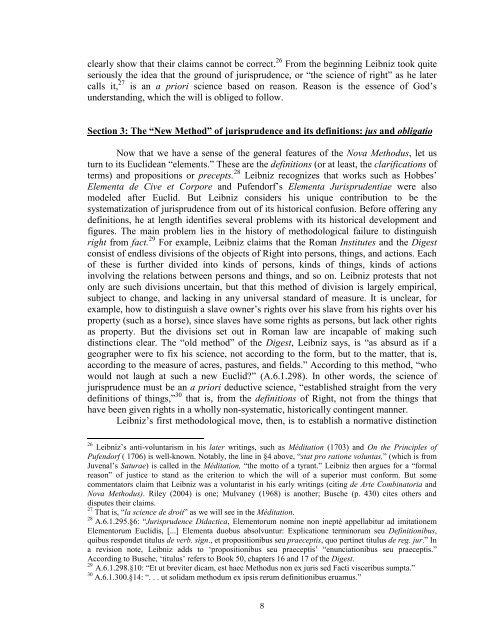Stony Brook University
Stony Brook University
Stony Brook University
You also want an ePaper? Increase the reach of your titles
YUMPU automatically turns print PDFs into web optimized ePapers that Google loves.
clearly show that their claims cannot be correct. 26 From the beginning Leibniz took quite<br />
seriously the idea that the ground of jurisprudence, or “the science of right” as he later<br />
calls it, 27 is an a priori science based on reason. Reason is the essence of God’s<br />
understanding, which the will is obliged to follow.<br />
Section 3: The “New Method” of jurisprudence and its definitions: jus and obligatio<br />
Now that we have a sense of the general features of the Nova Methodus, let us<br />
turn to its Euclidean “elements.” These are the definitions (or at least, the clarifications of<br />
terms) and propositions or precepts. 28 Leibniz recognizes that works such as Hobbes’<br />
Elementa de Cive et Corpore and Pufendorf’s Elementa Jurisprudentiae were also<br />
modeled after Euclid. But Leibniz considers his unique contribution to be the<br />
systematization of jurisprudence from out of its historical confusion. Before offering any<br />
definitions, he at length identifies several problems with its historical development and<br />
figures. The main problem lies in the history of methodological failure to distinguish<br />
right from fact. 29 For example, Leibniz claims that the Roman Institutes and the Digest<br />
consist of endless divisions of the objects of Right into persons, things, and actions. Each<br />
of these is further divided into kinds of persons, kinds of things, kinds of actions<br />
involving the relations between persons and things, and so on. Leibniz protests that not<br />
only are such divisions uncertain, but that this method of division is largely empirical,<br />
subject to change, and lacking in any universal standard of measure. It is unclear, for<br />
example, how to distinguish a slave owner’s rights over his slave from his rights over his<br />
property (such as a horse), since slaves have some rights as persons, but lack other rights<br />
as property. But the divisions set out in Roman law are incapable of making such<br />
distinctions clear. The “old method” of the Digest, Leibniz says, is “as absurd as if a<br />
geographer were to fix his science, not according to the form, but to the matter, that is,<br />
according to the measure of acres, pastures, and fields.” According to this method, “who<br />
would not laugh at such a new Euclid?” (A.6.1.298). In other words, the science of<br />
jurisprudence must be an a priori deductive science, “established straight from the very<br />
definitions of things,” 30 that is, from the definitions of Right, not from the things that<br />
have been given rights in a wholly non-systematic, historically contingent manner.<br />
Leibniz’s first methodological move, then, is to establish a normative distinction<br />
26 Leibniz’s anti-voluntarism in his later writings, such as Méditation (1703) and On the Principles of<br />
Pufendorf ( 1706) is well-known. Notably, the line in §4 above, “stat pro ratione voluntas,” (which is from<br />
Juvenal’s Saturae) is called in the Méditation, “the motto of a tyrant.” Leibniz then argues for a “formal<br />
reason” of justice to stand as the criterion to which the will of a superior must conform. But some<br />
commentators claim that Leibniz was a voluntarist in his early writings (citing de Arte Combinatoria and<br />
Nova Methodus). Riley (2004) is one; Mulvaney (1968) is another; Busche (p. 430) cites others and<br />
disputes their claims.<br />
27 That is, “la science de droit” as we will see in the Méditation.<br />
28 A.6.1.295.§6: “Jurisprudence Didactica, Elementorum nomine non ineptè appellabitur ad imitationem<br />
Elementorum Euclidis, [...] Elementa duobus absolvuntur: Explicatione terminorum seu Definitionibus,<br />
quibus respondet titulus de verb. sign., et propositionibus seu praeceptis, quo pertinet titulus de reg. jur.” In<br />
a revision note, Leibniz adds to ‘propositionibus seu praeceptis’ “enunciationibus seu praeceptis.”<br />
According to Busche, ‘titulus’ refers to Book 50, chapters 16 and 17 of the Digest.<br />
29 A.6.1.298.§10: “Et ut breviter dicam, est haec Methodus non ex juris sed Facti visceribus sumpta.”<br />
30 A.6.1.300.§14: “. . . ut solidam methodum ex ipsis rerum definitionibus eruamus.”<br />
8
















